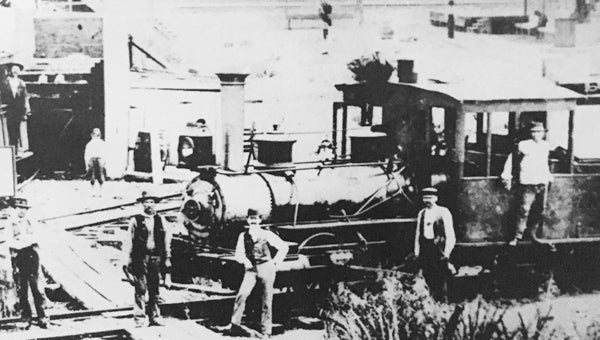Ruddock washed away 100 years ago
Published 12:20 am Wednesday, September 30, 2015

- Ruddock in St. John the Baptist Parish is shown in 1900. (Photo courtesy of Wayne Norwood)
What was once the thriving town of Ruddock is now only recognized by a sign, Exit 7, on Interstate 55.

Wayne Norwood points to some of the bottles on display at his Louisiana Treasures Museum in Ponchatoula. Norwood has spent many years studying Ruddock and has dived in the swamp to unearth artifacts.
Approximately ten miles north LaPlace, this land along Lake Ponchartrain was settled by German colonists in the early 1800s and became part of the railroad route in 1854. The railroad provided a valuable link for travel, buying and selling goods and lumber transportation for the Ruddock Cypress Company, which was incorporated in 1891.
Wayne Norwood has spent many years studying Ruddock and the surrounding area. He has also dived in the swamp to unearth artifacts.
He built and operates the Louisiana Treasures Museum to house his extensive collection.
Norwood recently wrote “The Day Time Stood Still: The Hurricane of 1915,” which describes life in Ruddock and chronicles the event that forever changed the town.
By 1915, Ruddock had a telegraph office, post office, train engine shop and a boarding house.
“The houses at Ruddock were on the east side of the tracks and were all two-story homes,” Norwood said. “There was a main walkway down the middle of the street, which was a slab of cypress cut and laid in the swampy area. Houses were on each side of the walkway, and a community center was located at the end.”
Scattered on the shore of the lake and along the railroad track were other houses. Five miles south of Ruddock was the train stop Wagram (later changed to Napton, because the people there rested for a couple of hours every afternoon) and farther south was Frenier, another train stop.
In 1990, Norwood interviewed Helen Schlosser Burg, born in Wagram in 1901, and recorded her exclusive story in his book. According to Burg, cabbage was the main crop grown by the residents. They also grew other vegetables, hunted game and always shared with their neighbors.
Should the residents need to buy anything from New Orleans, they would flag down the train and hand their grocery list to the engineer, who would return with their goods. Because of this, the engineer knew where each resident lived.
“We had no cars and no roads,” Burg told Norwood. “We knew about LaPlace, but a five- or ten-mile walk through the swamp to get there was too much. We had no doctors, and all the babies were delivered by a midwife. Our mother treated us when we got sick. We had no electricity either, and our water came from a cistern.”
On the west side of the railroad track was the Catholic church and school. A priest would come from New Orleans once a month, and school was held whenever a nun from New Orleans would arrive on the train.
Burg’s recollection of her childhood and the Hurricane of 1915 vividly paints a portrait of the day, 100 years ago, when the town of Ruddock and the surrounding area were destroyed.
The wind and the rain started on the night of Wednesday, Sept. 29, 1915, and continued until morning.
“The water had now risen about ten feet, and the waves were hitting against our house,” Burg told Norwood.
Believing that the train track would stop the water, her father put two of the five children in his small cypress boat, brought them to the railroad track, then went back for his wife and other children.
“We huddled together and put a table cloth over us so the rain wouldn’t hurt as much, but then it blew away,” Burg recalled. “Daddy was now trying to go into the wind, but he couldn’t get anywhere. The wind just kept blowing him back.”
He finally succeeded, and as soon as the family was reunited on the track, they crawled to the school house.
Once inside the school, the water they had escaped rose over the track and began to crash against the building. Fearing it would blow away, Burg’s father loaded the family into the small boat and swam alongside it deeper into the swamp.
They heard the train’s whistle in the distance as the engineer stopped at each home in an attempt to rescue people. As the train drew near the school, Burg’s family began to shout and paddle the boat with their hands. When they reached the tracks, they saw that the school had blown down.
The family boarded the train, but the train only traveled a few miles before the engineer noticed that the track ahead had washed away. He reversed the train up to the location of the school, then stopped, for the tracks there were also gone. The water was now two feet deep in the train, and those who had taken refuge inside knelt and prayed for hours.
The storm died down before the next morning, and survivors were left to search for the missing and walk through the swamp to obtain help. Twenty-eight people from the Ruddock area died, and only one house was left standing
The railroad was rebuilt; however, Ruddock was abandoned. The Hurricane of 1915, recorded as a Category 4 with winds as high as 145 mph, dealt a huge blow from which the town never recovered.
In her 1990 interview, Burg, who died only 30 days later, noted, “After we moved, the area, to this day, is still, quiet, and a forgotten place. But it holds the memories of the storm that took so many lives and changed our world forever on that September day in 1915.”
— Special by Ronny Michel




